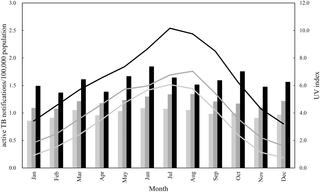Our official English website, www.x-mol.net, welcomes your
feedback! (Note: you will need to create a separate account there.)
Time-series analysis of geographically specific monthly number of newly registered cases of active tuberculosis in Japan.
PLOS ONE ( IF 2.9 ) Pub Date : 2019-03-18 , DOI: 10.1371/journal.pone.0213856 Ayako Sumi 1 , Nobumichi Kobayashi 1
PLOS ONE ( IF 2.9 ) Pub Date : 2019-03-18 , DOI: 10.1371/journal.pone.0213856 Ayako Sumi 1 , Nobumichi Kobayashi 1
Affiliation

|
BACKGROUND
Understanding seasonality of tuberculosis (TB) epidemics may lead to identify potentially modifiable risk factors. Studies conducted outside Japan have found seasonal variation among reported TB cases, with peaks in spring and summer and low prevalence in fall and winter. One hypothesis regarding spring or summer peaks in TB epidemics is that TB transmission likely increases in winter because of indoor crowding and poor ventilation, with development of primary TB among socially vulnerable people in spring and summer. Another plausible explanation is that vitamin D deficiency in winter depresses immunity, increasing the TB reactivation risk in these seasons. Previous studies suggest latitude-dependent factors, including reduced winter sunlight and its effect on vitamin D levels. Here, we investigated mechanisms of seasonality in TB epidemics in Japan, according to the effects of crowding and latitude.
METHODS
We used time-series analysis consisting of spectral analysis and least-squares method, to analyse geographically specific monthly number of newly registered cases of all forms of active TB in all 47 prefectures of Japan during 1998-2015.
RESULTS
In all power spectral densities for the 47 prefectures, spectral lines were observed at frequency positions corresponding to a 1-year cycle. The degree of this seasonality was associated with population density. We did not detect greater amplitude of seasonality at higher latitudes, suggesting that latitude-dependent factors, including reduced winter sunlight and its potential effect on vitamin D levels, do not contribute significantly to seasonality in Japan.
DISCUSSION AND CONCLUSION
In districts with high population density, measures are needed to address two specific types of active infection risk in adolescents and middle-aged adults: (i) public transport use, and (ii) irregular employment with no periodic medical examinations. To control active TB epidemics, investigating periodic structures in the temporal patterns of active TB in each district and each age group is important.
中文翻译:

对日本新登记的活动性肺结核病例按地理区域划分的每月数量的时间序列分析。
背景技术了解结核病(TB)流行病的季节性可能会导致确定潜在的可改变的危险因素。在日本以外进行的研究发现,报告的结核病病例之间存在季节差异,春季和夏季达到峰值,而秋季和冬季则较低。一种关于春季或夏季结核病流行高峰的假说是,由于室内拥挤和通风不良,冬季结核病的传播可能会增加,而春季和夏季,社会脆弱人群的原发性结核病也随之发展。另一个合理的解释是,冬季维生素D缺乏会降低免疫力,从而增加这些季节中结核病再激活的风险。先前的研究表明,纬度相关的因素,包括冬季日照减少及其对维生素D水平的影响。这里,我们根据拥挤和纬度的影响,调查了日本结核病流行的季节性机制。方法我们使用了包括光谱分析和最小二乘法在内的时间序列分析方法,以分析1998-2015年日本所有47个县的所有形式的活动性结核病新登记病例的地理特定月度数。结果在47个县的所有功率谱密度中,在与1年周期相对应的频率位置上观察到谱线。这种季节性的程度与人口密度有关。我们没有在较高的纬度上发现季节性的更大幅度变化,这表明日本依赖纬度的因素(包括冬季日照减少及其对维生素D含量的潜在影响)对季节性没有显着影响。讨论和结论在人口密度高的地区,需要采取措施来解决两种特殊类型的青少年和中年人的主动感染风险:(i)公共交通工具的使用,以及(ii)没有定期医疗检查的非正规就业。为了控制活动性结核病的流行,调查每个地区和每个年龄段的活动性结核病的时间结构的周期性结构很重要。
更新日期:2019-03-19
中文翻译:

对日本新登记的活动性肺结核病例按地理区域划分的每月数量的时间序列分析。
背景技术了解结核病(TB)流行病的季节性可能会导致确定潜在的可改变的危险因素。在日本以外进行的研究发现,报告的结核病病例之间存在季节差异,春季和夏季达到峰值,而秋季和冬季则较低。一种关于春季或夏季结核病流行高峰的假说是,由于室内拥挤和通风不良,冬季结核病的传播可能会增加,而春季和夏季,社会脆弱人群的原发性结核病也随之发展。另一个合理的解释是,冬季维生素D缺乏会降低免疫力,从而增加这些季节中结核病再激活的风险。先前的研究表明,纬度相关的因素,包括冬季日照减少及其对维生素D水平的影响。这里,我们根据拥挤和纬度的影响,调查了日本结核病流行的季节性机制。方法我们使用了包括光谱分析和最小二乘法在内的时间序列分析方法,以分析1998-2015年日本所有47个县的所有形式的活动性结核病新登记病例的地理特定月度数。结果在47个县的所有功率谱密度中,在与1年周期相对应的频率位置上观察到谱线。这种季节性的程度与人口密度有关。我们没有在较高的纬度上发现季节性的更大幅度变化,这表明日本依赖纬度的因素(包括冬季日照减少及其对维生素D含量的潜在影响)对季节性没有显着影响。讨论和结论在人口密度高的地区,需要采取措施来解决两种特殊类型的青少年和中年人的主动感染风险:(i)公共交通工具的使用,以及(ii)没有定期医疗检查的非正规就业。为了控制活动性结核病的流行,调查每个地区和每个年龄段的活动性结核病的时间结构的周期性结构很重要。











































 京公网安备 11010802027423号
京公网安备 11010802027423号